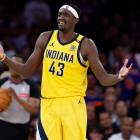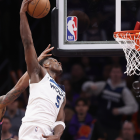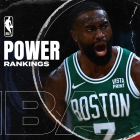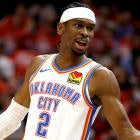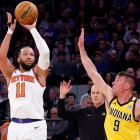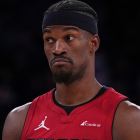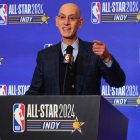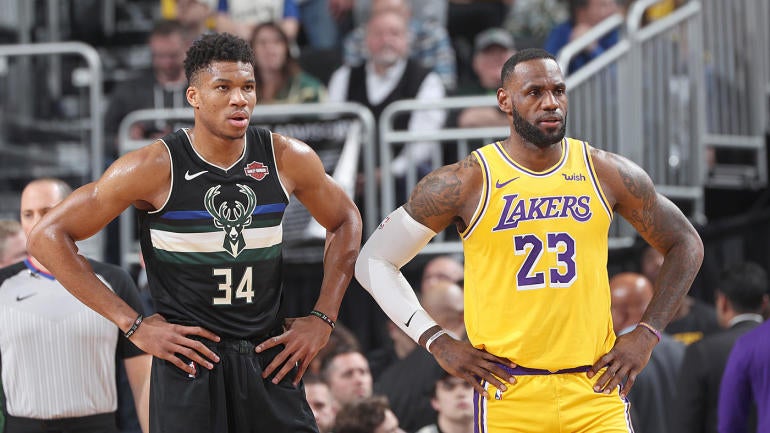
First, it was the Miami Heat. Despite being a rumored-pursuer of Giannis Antetokounmpo in free agency, the Heat cut into their 2021 cap space by signing Bam Adebayo to an early contract extension. Now, the Los Angeles Lakers have followed suit. By signing LeBron James to a two-year, $85 million contract extension, they have all but surrendered on the idea of creating max space next offseason, when Giannis could be available.
Unlike Adebayo, James is not getting a substantial raise. If we're being absolutely technical, the Lakers have no less control over their cap situation today than they did yesterday. The original contract James signed in 2018 gave him a $41,002,273 player option for the 2021-22 season, his maximum possible salary. His projected cap figure for the 2021-22 season is only slightly higher at $41,180,544, 105 percent of his previous salary, but there's a major difference. That salary is now set in stone. When James had that option, he theoretically could have opted out in order to help the Lakers clear space for Giannis. Had he done so, they might have been able to make him an offer within range of his max.
Assume, for the time being, that next season's cap is $112,414,200. That is a three percent increase on the current $109,140,000 cap, which is the league's current projection. For the sake of argument, we will also say that the Lakers are willing and able to get off of all of their other movable obligations. That means trading Kentavious Caldwell-Pope, having Montrezl Harrell and Marc Gasol decline their options and renouncing their rights to free agents Alex Caruso, Kyle Kuzma and Dennis Schroder. Even with those moves, the Lakers would still have the following immutable financial obligations.
- The Lakers used the stretch provision to waive Luol Deng in 2018. That left them with $5 million in dead money for the 2021-22 season. The Lakers applied for a career-ending injury exemption to have that money removed from their books, but were denied. That money cannot be removed for any reason.
- When teams have fewer than 12 players on their roster in the offseason, they create an incomplete roster charge for every player below 12 on their books. That charge is equal to the rookie minimum salary, which would be a projected $988,139 under that $112.4 million cap. If the Lakers cleared every player on their roster except James and Anthony Davis, they would have 10 of these charges eating into their cap space. That's $9,881,390 less cap space for them to play with.
Now, all we need to is subtract. Take $14,981,390 out of a $112,414,200 cap and you get $97,432,810. That is how much cap space the Lakers could have leftover to spread between James, Davis and Antetokounmpo, assuming Davis signs either a one-year deal for this season or has a player option for next season. If James had opted out and the three had agreed to take even salaries, they each would have made $32,477,603. For LeBron, that would have represented a meaningful sacrifice. He'd have left almost $7 million on the table based on what he could command on the free market and over $8 million compared to what his option would have represented thanks to the annual raises built into his contract. But Davis and Antetokounmpo would have been taking only minor cuts, around $1.3 million per year in the first season. That might have been feasible. After all, James, Dwyane Wade and Chris Bosh gave up similar amounts when they signed with the Miami Heat in 2010. Precedent existed.
But now that James is locked in at over $41 million? Those cuts are much bigger. The Lakers would now have $56,252,266 to split between Davis and Antetokounmpo. That's only $28,126,133 each, obviously a lot of money, but a steep decline from what each could get. Each would be sacrificing around $5.6 million in the first year. If they signed long-term deals, those sacrifices would be even greater. For Davis, it would be around $33 million across five years, and for Antetokounmpo, it would be approximately $24 million over four.
There are ways mitigate some of those sacrifices over time using short-term deals, various forms of Bird Rights and the higher max salaries that come when a player hits 10 years of NBA experience (Davis is currently two years short, while Giannis is three), but the basic principle here is the same: LeBron signing this extension makes it extremely unlikely that the Lakers will be able to create the cap space to sign Giannis outright. Even if he is willing to give up money to be a Laker, would Davis make that sacrifice when James didn't? It's unknowable but unlikely.
The Heat also sacrificed its max space to re-sign Adebayo, but they left themselves an alternative route to paying Giannis the max: a sign-and-trade. The Heat signed a number of their own free agents to big contracts with hefty team options for next season. That creates a clear sign-and-trade formula: those team options would serve as the matching salary, while youngsters like Tyler Herro, Duncan Robinson and Kendrick Nunn could represent the value headed to Milwaukee. It isn't clear that the Lakers could satisfy either element of that equation.
The Lakers would need to send out nearly $27 million to absorb Giannis at his $33.7 million max. They would just barely get there if Harrell and Gasol opt-in, as they could package their four tradeable salaries (those two, Caldwell-Pope and the non-guaranteed deal of Alfonzo McKinnie) to get to around $27.3 million. If Harrell or Gasol chose to opt-out? They'd have to sign-and-trade one or more of their own free agents to get there. That presents the complication of those players possibly not wanting to play for the Bucks. At the very least, all of this means that the Lakers would need help from at least one factor out of their control to match enough salary to make this trade.
And then there's the value component of this deal. The Heat can offer Herro, a possible young star. The Lakers could offer... Kyle Kuzma in a sign-and-trade? Alex Caruso in a sign-and-trade? That's not much value even if they agreed to join the Bucks. The Lakers could throw in their 2027 first-round pick, but that's still a far cry from Herro.
But okay, let's say the Bucks cooperated and a deal could be reached. The Lakers would have a very hard time filling out their team afterward because of the hard-cap that triggers upon the acquisition of any player through a sign-and-trade. That hard cap is the apron, which we'd project to fall somewhere in the neighborhood of $142 million. James is locked in at just under $42 million. If Davis and Antetokounmpo made their maxes, that's another $33.7 million apiece, and Deng's $5 million in dead money would still be on the books. That's around $113.6 million. The Lakers wouldn't even have $30 million to fill in their remaining 12 roster spots. As great as a James-Davis-Antetokounmpo trio would be, could they win a championship with no depth? And James at 37-years-old? Even if the answer is yes, could they convince Giannis of that?
If recent NBA history has taught us anything, it's that when a superstar wants to play for a specific team, he usually finds a way to do so. We don't know whether or not Giannis is interested in being a Laker, but if he is, odds are, he'll find a way to make that dream a reality.
But the finances involved just got a good deal more complicated. A week after the Heat gave up on their pursuit of max cap space, the Lakers have seemingly done the same. Maybe that means they expect Giannis to remain in Milwaukee, or maybe it means they're sending a message to Giannis about how he'll be treated once he does leave Milwaukee. Either way, it's a seismic shift compared to the typical financial prudence teams show ahead of major free-agent pursuits. The Lakers and Heat are spending like cap space doesn't matter, and for all we know, it might not.














